- Home
- Bertolt Brecht
Berliner Ensemble Adaptations
Berliner Ensemble Adaptations Read online
Berliner Ensemble Adaptations
BERTOLT BRECHT
Bertolt Brecht was born in Augsburg on 10 February 1898 and died in Berlin on 14 August 1956. He grew to maturity as a playwright in the frenetic years of the twenties and early thirties, with such plays as Man Equals Man, The Threepenny Opera and The Mother. He left Germany when Hitler came to power in 1933, eventually reaching the United States in 1941, where he remained until 1947. It was during this period of exile that such masterpieces as Life of Galileo, Mother Courage and her Children and The Caucasian Chalk Circle were written. Shortly after his return to Europe in 1947, he founded the Berliner Ensemble, and from then until his death mainly directed and supervised productions of a wide variety of plays, including his own.
David Barnett is Reader in Drama, Theatre and Peformance at the University of Sussex. He has published monographs on Heiner Müller (1998) and Rainer Werner Fassbinder (2005, paperback 2009), and has co-edited a volume and edited a special issue of Contemporary Theatre Review on contemporary German theatre. He is the author of Brecht in Practice: Theatre, Theory and Performance (2014) and A History and the Berliner Ensemble (forthcoming).
Also by Bertolt Brecht
PLAYS
Brecht Collected Plays: One
(Baal, Drums in the Night, In the Jungle of Cities, The Life of Edward II of England, A Respectable Wedding, The Beggar or the Dead Dog, Driving Out a Devil, Lux in Tenebris, The Catch)
Brecht Collected Plays: Two
(Man Equals Man, The Elephant Calf, The Threepenny Opera, The Rise and Fall of the City of Mahagonny, The Seven Deadly Sins)
Brecht Collected Plays: Three
(Lindbergh’s Flight, The Baden-Baden Lesson on Consent, He Said Yes/He Said No, The Decision, The Mother, The Exception and the Rule, The Horations and the Curiatians, St Joan of the Stockyards)
Brecht Collected Plays: Four
(Round Heads and Pointed Heads, Fear and Misery of the Third Reich, Señora Carrar’s Rifles, Dansen, How Much Is Your Iron?, The Trial of Lucullus)
Brecht Collected Plays: Five
(Life of Galileo, Mother Courage and Her Children)
Brecht Collected Plays: Six
(The Good Person of Szechwan, The Resistible Rise of Arturo Ui, Mr Puntila and His Man Matti)
Brecht Collected Plays: Seven
(The Visions of Simone Machard, Schweyk in the Second World War, The Caucasian Chalk Circle, The Duchess of Malfi)
Brecht Collected Plays: Eight
(The Days of the Commune, The Antigone of Sophocles, Turandot or the Whitewashers’ Congress)
PROSE
Brecht on Theatre
Brecht on Art and Politics
Brecht on Film and Radio
Diaries 1920–1922
Journals 1934–1955
Brecht on Performance
Contents
Introduction: Adaptations for the Berliner Ensemble
The Tutor by J. M. R. Lenz
Translated by Ralph Manheim and Wolfgang Sauerlander
Coriolanus by William Shakespeare
Translated by Ralph Manheim
The Trial of Joan of Arc at Rouen, 1431 by Anna Seghers
Translated by Ralph Manheim and Wolfgang Sauerlander
Don Juan by Molière
Translated by Ralph Manheim
Trumpets and Drums by George Farquhar
Translated by Rose and Martin Kastner
Notes
Introduction: Adaptations for the Berliner Ensemble
Bertolt Brecht is celebrated as a dramatist in his own right, but he was also involved in literary collaborations for the duration of his career as a writer. He gathered a group of friends around himself as a young man in Augsburg to exchange ideas and discuss their literary work, and the practice continued with different writers, directors and dramaturges until his death in 1956. Another form of collaboration, however, is to be found in Brecht’s relationship with the work of other playwrights. His first full-length play, Baal, was a direct and critical engagement with Hanns Johst’s The Lonely Man, yet, over the years, Brecht also developed more intimate relationships to source texts in the form of adaptations. His approach was not dictated by a standard approach but by complex responses to the dramatic material in question. Brecht’s The Life of Eduard II of England, for example, was a radical dismemberment and reassembly of Marlowe’s play, while Brecht preserved many important elements of John Gay’s The Beggars Opera in The Threepenny Opera. Round Heads and Pointed Heads began as an adaptation of Measure for Measure before taking a completely different direction and leaving little more than a passing resemblance to Shakespeare’s play. However, once Brecht had a theatre of his own, the Berliner Ensemble (BE), his approach to adaptation began to take its lead from a series of political and aesthetic principles, as we shall see below. The adaptations in this volume, which were written between the BE’s first season (1949–50) and the last one Brecht would experience (1955–6), conform to these principles, but, as will become evident, their application did not lead to standardized output by any means. In order to understand this shift to a different, more focused form of adaptation, we need to appreciate what having his own theatre meant to Brecht and how this affected the work he sought to bring to it.
* * * * *
Brecht, together with his wife, Helene Weigel, and their children, had been in exile in a number of countries since the Nazis came to power in 1933. During this period Brecht had very little access to the theatre and instead devoted most of his creative energy to writing plays, poems and theoretical texts. Having left the USA in October 1947, after a not untraumatic hearing at the hands of the McCarthyite House Un-American Activities Committee, he journeyed on to Zurich via Paris, and contemplated a return to active theatre-making. At this time, it was by no means certain that he would settle in the Soviet zone of Berlin. Although the Soviets had offered him incentives, he flirted with relocating to Salzburg and Munich but these plans came to nothing.
By late 1948 Brecht finally decided to return to Berlin, the site of his only major triumph to date, The Threepenny Opera. Yet the theatre in which it premiered under the direction of Erich Engel in 1928, the Theater am Schiffbauerdamm, was already occupied by a company under the leadership of Fritz Wisten. Indeed, there seemed to be no room at all in what would become East Berlin for Brecht and a new ensemble; it looked like he had arrived in Germany too late. So, with this lack of free space in mind, he sought to attach the new ensemble he proposed, at least for the short term, to an existing theatre. The East German government was planning to rebuild another major theatre, the Volksbühne, with a view to moving Wisten and his troupe there and allowing Brecht to return to the Schiffbauerdamm. Estimates concerning the building project were hopelessly optimistic, however. In the meantime, the BE, with Weigel as general manager and Brecht as artistic director, was supposed to spend just one season at Wolfgang Langhoff’s Deutsches Theater. As it turned out, they remained there until 1953.
After much to-ing and fro-ing between the various institutions that ran Berlin before the foundation of the German Democratic Republic (GDR) on 7 October 1949, Weigel finally signed a contract with the Department of People’s Education that brought the BE into existence on 1 September. The initial question that confronted the new company was what it was going to perform. Brecht certainly had enough plays of his own and, indeed, opened the new season on 12 November with Mr Puntila and his Man Matti. However, he was reluctant to turn his company into a vehicle solely for realizing his own dramas and wanted a greater mix, including contemporary and classic plays, that could make an active contribution to the cultural life of the city and its citizens.
While Brecht was inter
ested in attracting other directors to work at the BE, he was also keen to develop his own theorized practice now that he had regular access to a proper stage. This he could not do alone and so he re-activated old contacts, such as Erich Engel and his school friend, the set-designer Caspar Neher. Yet these were collaborators of Brecht’s generation, and one of the BE’s missions was to test out and disseminate a new way of making theatre. Consequently, Brecht recruited a team of young assistants who were to learn from him, not by spending hours in the archive reading his unpublished theories, but by observing him at work, making suggestions, and reflecting on the work they observed in their own detailed and analytical rehearsal notes. Brecht created a circle of enthusiastic, committed theatre-makers with whom he could collaborate and advance his ideas. Yet the tasks he set them extended well beyond the rehearsal room.
In a bid to build the BE’s repertoire, Brecht returned to the practice of adaptation, but also exploited the process of adaptation as a means of developing his young assistants. That is, he was able to focus his assistants’ nascent interests and abilities by encouraging them to edit and, indeed, to adulterate existing texts while reserving his own place as editor-in-chief and writer of additional material. But the repertoire was not merely to comprise a collection of Brecht’s favourite plays; Brecht was profoundly aware that he had opted to live in the first (and, as yet, last) socialist state on German soil and set about fashioning a repertoire worthy of that state. So, while he implemented ideas that had fermented during his long exile – from developing an active ensemble on stage to assembling a dynamic team he envisaged as able successors in due course – he did not neglect the material his predominantly young cast and crew were to perform. The adaptations, which would become something of a staple at the BE, were written in such a way that they would exemplify the social aims of the company, and these can be seen in the criteria Brecht set down for his young assistants.
* * * * *
The first text Brecht selected for adaptation was The Tutor, written by J. M. R. Lenz in 1774. Lenz was one of a disparate group of energetic young writers who would collectively be known as the ‘storm and stress’ movement, or Sturm und Drang. His dramatic output is marked by its bold themes and formal innovation; indeed his play The Soldiers can be read as a precursor to Brecht’s epic theatre in that it regularly features scenes in which characters comment explicitly on the action rather than participate in it, like Brecht’s narrators. The Tutor, a play that is today regarded as a classic of the ‘storm and stress’ period, was, in 1949, little-known and ripe for rediscovery. However, Brecht was not prepared to direct it as it stood and engaged his assistants in the process of adaptation. In the following extract, we can see the sort of tasks he set. This systematic approach to adaptation may have been implicit to his own practices previously but the overt statement of its tenets signalled a set of principles which informed both his thoughts about the nature of dramatic source texts and how they might be realized at the BE.
First, he asked his assistants to trim 30 minutes off the total running time. He then wanted them to:
2. establish clearly the central Fabel (the account of the real events) so that it is easily understandable, while retaining the elegance of the sequence of the scenes,
3. arrange the subplots around the central Fabel so that they illuminate and explicate the latter smoothly without interrupting it,
4. eliminate the untypical, accidental or purely pathological features in the motivation of the action and the characters.
The instructions point to several important aspects of an adaptation for Brecht. Items 2 and 3 put an unmistakable emphasis on clarity. The organization of the main plot and the subplot had to serve the purpose of drawing clear through-lines in the complicated course of events. Lenz, who, like other storm-and-stress playwrights, was influenced by Shakespeare, wanted to give his play the richness and liveliness associated with Shakespeare’s dramas. Brecht, however, sought to impose order upon the various plots as a way of deepening the treatment of the central themes, rather than taking in too many extraneous meanderings, as he saw them. It should be noted, however, that this formal reorganization was not to interfere with the beauty of the play’s flow. Brecht was not suggesting a utilitarian butchering of the play’s form; instead he wanted to combine his aims with the qualities that made Lenz’s play so attractive to him in the first place. This respect towards the unique appeal of all the source texts in this volume is one factor that prevented the adaptations from becoming mechanical or repetitive: each work had to be confronted on its own terms and only then could adaptation proceed.
Item 4 deals more specifically with issues concerning Brecht’s political aims for the adaptation as the basis for a successful performance. The direction to eliminate certain elements again concerns itself with clarity. In addition, the three elements also tell us about the type of material that was not admissible in a text designed to engage the audience’s critical faculties to the full. Eliminating the untypical meant that spectators could contemplate characters and events which were not in some way out of the ordinary but ones which would have concrete significance for them. Similarly, the accidental relied too much on chance to offer an audience material from which it could make meaningful connections about the world and the way it worked. Brecht maintained here that the representation of the world on stage had to be exemplary – it could not simply follow the foibles of everyday life but had consciously to aim to reproduce actions that were important and intelligible to an audience. If spectators were to learn anything, then exceptional or accidental material could not be included. The prohibition on ‘pathological features’ indicates another area Brecht deemed beyond the remit of a politically committed drama, in that such conditions were innate and thus unchangeable. While scholarly work has subsequently posited links between mental illness and the mechanisms of society, at that time, socialist states considered psychoanalysis and psychotherapy bourgeois and alien to working people.
The three items thus show how Brecht’s formal adaptation process focused on offering material to the audience defined by its usefulness. The unswerving drive towards clarity should not, however, be mistaken for a desire to make things easy for the audience. Brecht’s theatre was based on posing questions which only the spectators could answer. ‘Clarity’, then, involved articulating these questions as clearly as possible. The questions came in the form of on-stage contradictions. In The Tutor, for example, the audience was confronted with the central issue of why an intelligent tutor had to sell his services and demean himself in order to survive in the society of the time. Brecht thus sought to make the articulation of that difficult contradiction clear while the responses to it were complex and a matter for the audience.
Adaptation was not only a business that concerned the form of a play. Certain aspects of the original’s themes were also important. For example, Lenz’s play contains a reformist streak, suggesting that class and educational systems were capable of repair under feudalism. Brecht disagreed with this position and both deleted the first scene from Lenz’s second act and rewrote the main voice of reform, Major von Berg, in order to expunge this suggestion from the play. As a Marxist, Brecht wanted to point to the failings of the system itself and suggest that only revolution was the appropriate solution. However, the accuracy of the depiction of feudalism and those involved in it should equally demonstrate just how difficult it would be to engineer such social and political upheaval.
Formal and thematic adaptation served to heighten the central theme of the play in Brecht’s reading: the German ‘misère’. Broadly speaking, this term refers to the German people’s inability to bring about a successful social revolution, unlike the French in 1789. The Peasants’ Revolt of the early sixteenth century and the bourgeois uprising of 1848 both came to nothing and the patchwork of German states retained their class-based hierarchy. Brecht also noted in the unpublished introduction to Turandot that even in the most terrible days at the end of World W
ar Two, the German proletariat had not seized the moment and risen up against the Nazis. To Brecht, The Tutor was an object lesson in servility and deference to one’s social ‘superiors’, and he wanted the production to use comedy as a way of pointing to this attitude with a view to overcoming it.
Adaptation was also much more than merely cutting and reworking the text into a finished product; it was an ongoing process that ran through rehearsals. Several drafts of The Tutor exist and chart the ways in which practical work affected the architecture and feel of the new script. Rehearsal would reveal just how successful the current draft had been and the rhythm of lines, speeches, dialogues and scenes would change in accordance with the effects generated on stage. It is worth noting that this was an experimental process: actors were not required merely to perform what they found on the page but to plumb the text’s depths and make discoveries which may not have been apparent to the adapters. The discoveries would then inform the next draft. The lack of a definitive end point for the script, for example, is betokened by the fact that Brecht wrote the epilogue to The Tutor very late in the day. Up until then, the cast had used the more general epilogue to The Good Person of Szechwan. This shows how the team were not working towards this end from the outset; on the contrary, the epilogue took the material developed previously and made its own concluding remarks.

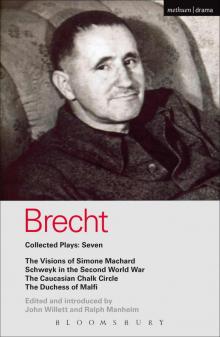 Bertolt Brecht: Mutter Courage und ihre Kinder 7
Bertolt Brecht: Mutter Courage und ihre Kinder 7 Bertolt Brecht
Bertolt Brecht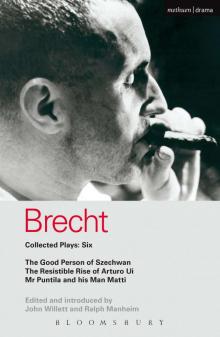 Bertolt Brecht: Mutter Courage und ihre Kinder 6
Bertolt Brecht: Mutter Courage und ihre Kinder 6 Bertolt Brecht: Mutter Courage und ihre Kinder 4
Bertolt Brecht: Mutter Courage und ihre Kinder 4 Bertolt Brecht: Mutter Courage und ihre Kinder 2
Bertolt Brecht: Mutter Courage und ihre Kinder 2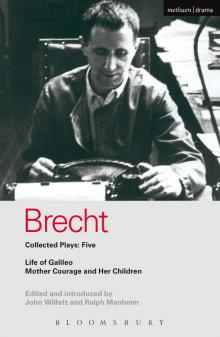 Bertolt Brecht: Mutter Courage und ihre Kinder 5
Bertolt Brecht: Mutter Courage und ihre Kinder 5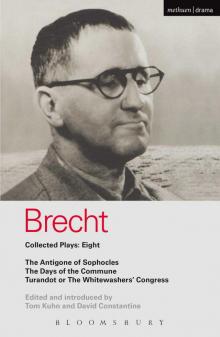 Collected Plays, Volume 4 (Bertolt Brecht: Plays, Poetry & Prose) 8
Collected Plays, Volume 4 (Bertolt Brecht: Plays, Poetry & Prose) 8 Mother Courage and Her Children
Mother Courage and Her Children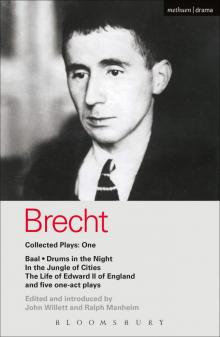 Bertolt Brecht: Mutter Courage und ihre Kinder 1
Bertolt Brecht: Mutter Courage und ihre Kinder 1 Brecht Collected Plays: 3: Lindbergh's Flight; The Baden-Baden Lesson on Consent; He Said Yes/He Said No; The Decision; The Mother; The Exception & the ... St Joan of the Stockyards (World Classics)
Brecht Collected Plays: 3: Lindbergh's Flight; The Baden-Baden Lesson on Consent; He Said Yes/He Said No; The Decision; The Mother; The Exception & the ... St Joan of the Stockyards (World Classics)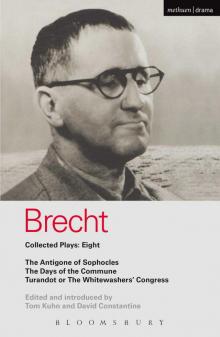 Brecht Plays 8: The Antigone of Sophocles; The Days of the Commune; Turandot or the Whitewasher's Congress: The Antigone of Sophocles , The Days of the Comm (World Classics)
Brecht Plays 8: The Antigone of Sophocles; The Days of the Commune; Turandot or the Whitewasher's Congress: The Antigone of Sophocles , The Days of the Comm (World Classics)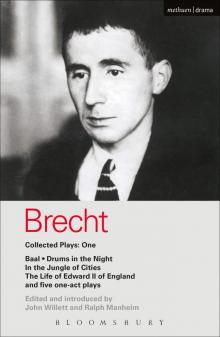 Brecht Collected Plays: 1: Baal; Drums in the Night; In the Jungle of Cities; Life of Edward II of England; & 5 One Act Plays: Baal , Drums in the Night , In the Jungle of Ci (World Classics)
Brecht Collected Plays: 1: Baal; Drums in the Night; In the Jungle of Cities; Life of Edward II of England; & 5 One Act Plays: Baal , Drums in the Night , In the Jungle of Ci (World Classics)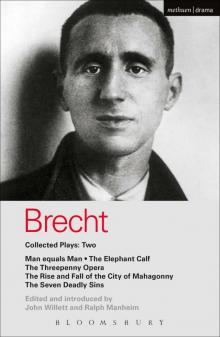 Brecht Collected Plays: 2: Man Equals Man; Elephant Calf; Threepenny Opera; Mahagonny; Seven Deadly Sins: Man Equals Man , Elephant Calf , Threepenny Ope (World Classics)
Brecht Collected Plays: 2: Man Equals Man; Elephant Calf; Threepenny Opera; Mahagonny; Seven Deadly Sins: Man Equals Man , Elephant Calf , Threepenny Ope (World Classics)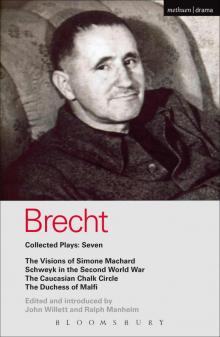 Brecht Collected Plays: 7: Visions of Simone Machard; Schweyk in the Second World War; Caucasian Chalk Circle; Duchess of Malfi (World Classics)
Brecht Collected Plays: 7: Visions of Simone Machard; Schweyk in the Second World War; Caucasian Chalk Circle; Duchess of Malfi (World Classics)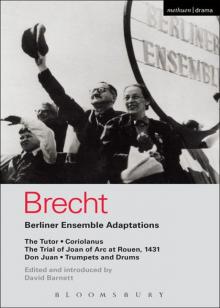 Berliner Ensemble Adaptations
Berliner Ensemble Adaptations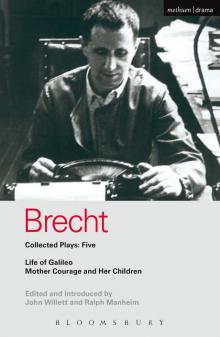 Brecht Collected Plays: 5: Life of Galileo; Mother Courage and Her Children (World Classics)
Brecht Collected Plays: 5: Life of Galileo; Mother Courage and Her Children (World Classics)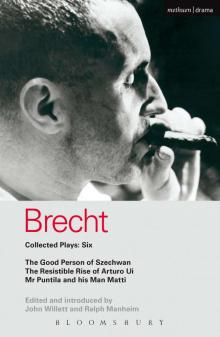 Brecht Collected Plays: 6: Good Person of Szechwan; The Resistible Rise of Arturo Ui; Mr Puntila and his Man Matti (World Classics)
Brecht Collected Plays: 6: Good Person of Szechwan; The Resistible Rise of Arturo Ui; Mr Puntila and his Man Matti (World Classics)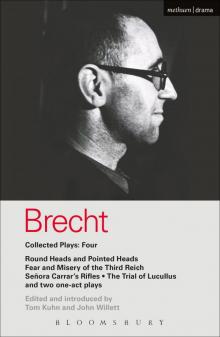 Brecht Collected Plays: 4: Round Heads & Pointed Heads; Fear & Misery of the Third Reich; Senora Carrar's Rifles; Trial of Lucullus; Dansen; How Much Is ... and Misery , Carr (World Classics)
Brecht Collected Plays: 4: Round Heads & Pointed Heads; Fear & Misery of the Third Reich; Senora Carrar's Rifles; Trial of Lucullus; Dansen; How Much Is ... and Misery , Carr (World Classics)